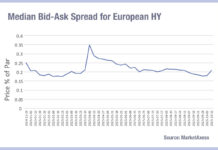Corporate bond markets are rapidly electronifying on both sides of the Atlantic. Electronification of trading creates a virtuous circle for delivering faster, more standardised transactions that are recorded in real time, so that data on transactions can more rapidly be used to support price and liquidity formation for future trades.
Where there is data, there can be automation, and so greater electronification and data transparency are precursors to greater automation.
That said, in corporate bond markets nothing is straightforward. Firstly, liquidity patterns in corporate bond trading are characterised by peaks and troughs. Bond pricing and returns are far less fluid than equities and so their turnover by investors is limited, meaning buying and holding is more common.
The frequent issuance of bonds of different tenors to support corporates’ financing needs also makes for a very active primary market and a much more complex universe of securities to trade than in equities. Aggregating that into a clear picture of trading activity is really challenging.
For banks, who act as the counterparties to investors, this structure requires them to hold bonds they have bought from clients on their books while they try to find a buyer. This has a cost, as there are regulatory requirements for banks to apportion capital to balance the risk that they carry by holding bonds. The more capital used as a buffer against the bond inventory, the less capital available to deploy in profit generation.
“Over time, the length of time bonds are in inventory will continue to reduce, driven by more automated internalisation and back-to-back hedging, while the number of bonds quoted by dealer will also reduce, moving from a one stop shop concept to a specialist concept,” noted one bank capital markets specialist.
Last year, Morgan Stanley and Oliver Wyman released a blue paper that found, “Global capital rules, as proposed and in some cases finalised, would place increasing pressure on banks’ ability to hold risk and provide capital and liquidity to the market. Non-bank liquidity providers and commodities traders are already well-positioned to capture any share released by banks, extending a trend that has been visible since the post-GFC regulatory reforms; we estimate that $10-12 BN in US trading revenue could shift to these players under proposed US capital rules.”
Consequently, banks want to offload bonds they have bought as efficiently as possible. Automation is one piece of that efficiency jigsaw. If automation is used with the goal of recycling risk for the sell-side trading desk, then it will also help increase the velocity of balance sheet.
A more automated credit market structure could therefore change the impact of extra capital costs for dealers, allowing them to hold on to a greater share of market making in corporate bond trading.
That said, automation is not a panacea. Sell-side traders note that while it potentially increases balance sheet velocity, the need for greater data – and therefore transparency – in the market can increase risks for banks, who may have their positions made visible to the market, which in turn will increase the costs of trading out of them.
“Automation is linked to more transparency and if not balanced means more capital costs, because it may produce complexity in hedging,” notes one European investment banking head.
However, depending on where automation occurs, its impact will still be dependent on market structure. One dealer noted that without a central limit order book (CLOB) in credit, it is hard to imagine that efficiency could reach such a significant level that capital levels would be affected.
While that is not close to existing now, if credit markets were to follow the pattern of equity and FX markets, they would eventually see a far greater concentration of liquidity provision by a few big players. In that scenario, single books of liquidity, akin to CLOBs, would be far more viable. The ‘winners’ of that market could therefore reduce relative capital costs even as their market share, volumes and revenue increased.
©Markets Media Europe 2024
©Markets Media Europe 2025















